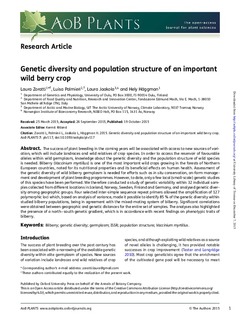| dc.contributor.author | Zoratti, Laura | |
| dc.contributor.author | Palmieri, Luisa | |
| dc.contributor.author | Jaakola, Laura | |
| dc.contributor.author | Häggman, Hely | |
| dc.date.accessioned | 2016-02-23T15:45:26Z | |
| dc.date.accessioned | 2017-08-25T07:28:08Z | |
| dc.date.available | 2016-02-23T15:45:26Z | |
| dc.date.available | 2017-08-25T07:28:08Z | |
| dc.date.issued | 2015 | |
| dc.identifier.citation | Zoratti, L., Palmieri, L., Jaakola, L., & Häggman, H. (2015). Genetic diversity and population structure of an important wild berry crop. AoB Plants, 7. | nb_NO |
| dc.identifier.issn | 2041-2851 | |
| dc.identifier.uri | http://hdl.handle.net/11250/2451808 | |
| dc.description.abstract | The success of plant breeding in the coming years will be associated with access to new sources of variation, which will include landraces and wild relatives of crop species. In order to access the reservoir of favourable alleles within wild germplasm, knowledge about the genetic diversity and the population structure of wild species is needed. Bilberry (Vaccinium myrtillus) is one of the most important wild crops growing in the forests of Northern European countries, noted for its nutritional properties and its beneficial effects on human health. Assessment of the genetic diversity of wild bilberry germplasm is needed for efforts such as in situ conservation, on-farm management and development of plant breeding programmes. However, to date, only a few local (small-scale) genetic studies of this species have been performed. We therefore conducted a study of genetic variability within 32 individual samples collected from different locations in Iceland, Norway, Sweden, Finland and Germany, and analysed genetic diversity among geographic groups. Four selected inter-simple sequence repeat primers allowed the amplification of 127 polymorphic loci which, based on analysis of variance, made it possible to identify 85 % of the genetic diversity within studied bilberry populations, being in agreement with the mixed-mating system of bilberry. Significant correlations were obtained between geographic and genetic distances for the entire set of samples. The analyses also highlighted the presence of a north–south genetic gradient, which is in accordance with recent findings on phenotypic traits of bilberry. | nb_NO |
| dc.language.iso | eng | nb_NO |
| dc.publisher | Oxford University Press on behalf of the Annals of Botany Company | nb_NO |
| dc.rights | Navngivelse 4.0 Internasjonal | * |
| dc.rights.uri | http://creativecommons.org/licenses/by/4.0/deed.no | * |
| dc.title | Genetic diversity and population structure of an important wild berry crop | nb_NO |
| dc.type | Journal article | nb_NO |
| dc.type | Peer reviewed | nb_NO |
| dc.date.updated | 2016-02-23T15:45:26Z | |
| dc.description.version | publishedVersion | nb_NO |
| dc.rights.holder | This is an Open Access article distributed under the terms of the Creative Commons Attribution License (http://creativecommons.org/licenses/by/4.0/), which permits unrestricted reuse, distribution, and reproduction in any medium, provided the original work is properly cited. | nb_NO |
| dc.source.pagenumber | 10 | nb_NO |
| dc.source.volume | 7 | nb_NO |
| dc.source.journal | AoB Plants | nb_NO |
| dc.identifier.doi | 10.1093/aobpla/plv117 | |
| dc.identifier.cristin | 1322670 | |

